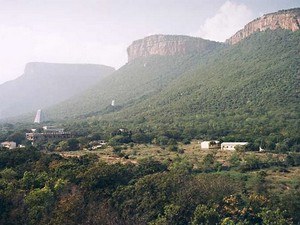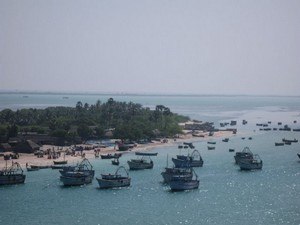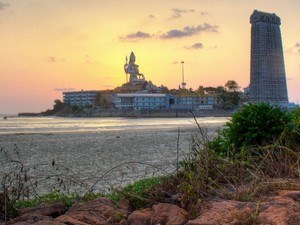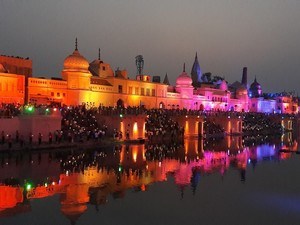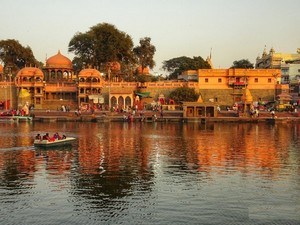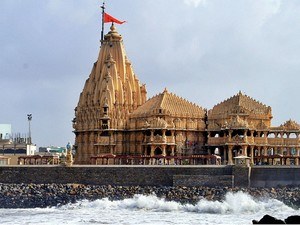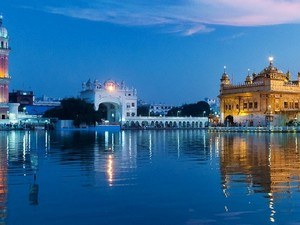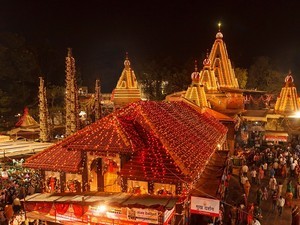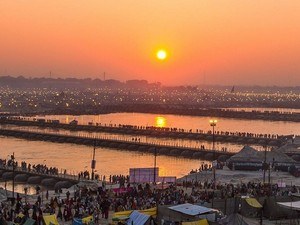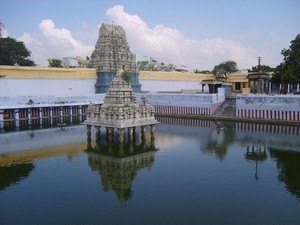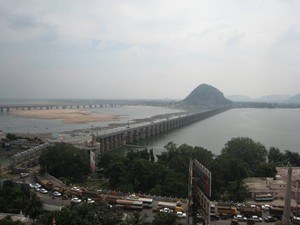1
DAY 1 : VARANASI SIGHTSEEING
DAY 1 : VARANASI SIGHTSEEING
 Sightseeing
Sightseeing
Leisure / No Sightseeing
About Kashi Vishwanath Temple / Golden Temple
At a distance of 5 Km from Varanasi Junction, Kashi Vishwanath Temple is an ancient Hindu temple situated on the banks of River Ganga in Varanasi city of Uttar Pradesh. Kashi Vishwanath Temple is dedicated to Lord Vishwanath, one of the incarnations of Lord Shiva and he is regarded as the patron deity of Varanasi. Popularly known as Golden Temple, it is one of the twelve jyotirlinga temples of Lord Shiva, and also one of the popular
pilgrimage sites in India. The temple was visited by many great saints including Ramakrishna Paramhansa, Swami Vivekananda, Maharishi Dayanand Saraswati, Goswami Tulsidas, Adi Shankaracharya and Gurunanak Dev. Lord Vishwanath is considered to the supreme origin of the spiritual truth and strengthens the bonds of universal brotherhood. It is believed that a single darshan of Vishweshwara Jyotirlinga is considered to auspicious more than the darshan of other .....
 Duration of visit: 1 Hour
Duration of visit: 1 Hour
 Timings: 4 AM to 11 PM
Timings: 4 AM to 11 PM
About Annapurna Devi Mandir
At a distance of 5 Km from Varanasi Junction, Annapurna Devi Mandir is a popular Hindu temple situated near Kashi Vishwanath Temple in Vishwanath Galli area of Varanasi, Uttar Pradesh. The temple is dedicated to Goddess Annapurna Devi, the Goddess of Food or the Goddess of Nourishment. It is believed that Goddess Parvati gave Alms to Shiva, and she is depicted with a bowl in one hand and ladle in the other, serving food to Shiva, standing in front of her with his begging bowl in the hand. Mata Annapurna is the Goddess of Varanasi who always protects Kashi and feeding her devotees. Having great religious importance in Hinduism, it is one of the must-include places in the
Varanasi pilgrimage packages.
History & Mythology of Annapurna Devi Mandir
Annapurna Devi Mandir was constructed by Maratha Peshwa Baji Rao in 1729 AD. According to the legend, the entire world .....
 Duration of visit: 30 Mins
Duration of visit: 30 Mins
 Timings: 4 AM to 10 PM
Timings: 4 AM to 10 PM
About Manikarnika Ghat
At a distance of 1 Km from Dasashwamedh Ghat and 6 Km from Varanasi Junction, Manikarnika Ghat is one of the holiest ghats along the banks of River Ganga in the sacred city of Varanasi. Situated just beside Dasashwamedh Ghat, it is the main cremation ghat in Varanasi, and among the most famous places to visit as part of the
Varanasi leisure tours. The Manikarnika Ghat is perpetually bustling with ceremonies and rituals, with pyres burning round the clock, and it is a poignant place where life and death intersect visibly. According to the religious beliefs, burning the dead bodies at this ghat is a way to attain Moksha, the salvation.
History of Manikarnika Ghat
The Manikarnika Ghat is vividly depicted in the Kashi Khanda and is commonly referred to as Mahashmashana, the grand cremation ground. Additionally, this ghat is mentioned in a Gupta inscription dating back to the .....
 Duration of visit: 30 Mins
Duration of visit: 30 Mins
 Timings: 24 Hours
Timings: 24 Hours
At a distance of 1 km from Dasashwamedh Ghat and 5 km from Varanasi Junction, Lalita Ghat is one of the main ghats on the Ganges River in Varanasi. This ghat is one of the most venerated ghats of Kashi for the devotees and is also identified among the seven most prominent ghats of Varanasi by Varanasi Tourism Department.
The ghat was built by King of Nepal, Rana Bahadur Shah in the early 19th century CE. The ghat is dedicated to Lalita Devi who is reckoned to be the personification of Goddess Durga. Devotees who come to this ghat believe that bathing at this ghat will earn the blessings of the Goddess.
Lalita Ghat is dotted with several Hindu temples. The well-known 'lingam' of Ganga Keshav and shrines of Gangatitya, Kashi Devi, Lalita Devi and Bhagirath Tirtha are affiliated to Lalita Ghat. Also known as Nepali Mandir, the Keshava temple was built by King of Nepal in typical Nepalese architecture. Also known as Kothwala Temple, thi is the replica of the famous Pashupatinath .....
 Duration of visit: 30 Mins
Duration of visit: 30 Mins
 Timings: Nepali Temple: 4 AM - 9 PM
Timings: Nepali Temple: 4 AM - 9 PM
BREAK FOR MEALS / HOTEL CHECK-IN | CHECK-OUT / SHOPPING / LEISURE
About Sri Kasi Vishalakshi Devi Temple
At a distance of 5 Km from Varanasi Junction, Sri Kashi Vishalakshi Temple is a Hindu temple situated at Mir Ghat on the banks of the Ganges at Varanasi in Uttar Pradesh, India. The temple is dedicated to Goddess Vishalakshi Devi, the divine form of Goddess Sati. This temple is one among the 51 Shakti Peethas, and is part of the famous triad of temples- Kanchi Kamakshi, Madurai Meenakshi and Kashi Vishalakshi. Situated near Kashi Vishwanath Mandir, it is among the popular temples in Uttar Pradesh, and also one of the must visit places as part of the
Varanasi family packages.
History & Mythology of Sri Kasi Vishalakshi Devi Temple
The Sri Kashi Vishalakshi Devi Temple was established and is preserved by the Nattukottai Nagarathar, a trading community originating from Tamil Nadu. The temple's narrative is closely linked to the tale of Sati, the daughter of .....
 Duration of visit: 30 Mins - 1 Hr
Duration of visit: 30 Mins - 1 Hr
 Timings: 4.30 AM - 11 AM & 5 PM - 10 PM
Timings: 4.30 AM - 11 AM & 5 PM - 10 PM
About Dasashwamedh Ghat
At a distance of 6 Km from Varanasi Junction, Dasashwamedh Ghat is a sacred ghat on the banks of River Ganga in the holy town of Varanasi. Located close to Vishwanath Temple, Dasashwamedh Ghat is the main ghat in Varanasi, and also one of the popular places to visit as part of the
Varanasi luxury tours. This is also the busiest ghat. On the tenth waxing fortnight of the Jyeshtha (May/June) worship of the Ganga is celebrated on a grand scale in the Ganga temple at the top of the ghat. Dashashwamedh Ghat is a popular destination for pilgrims and tourists who come to witness the sacred rituals, take part in boat rides, and soak in the spiritual ambiance of Varanasi.
History & Mythology of Dasashwamedh Ghat
Dashashwamedh Ghat is translated as the 'Ghat of Ten Horses.' This name originates from an ancient legend in which Lord Brahma conducted a ten-horse sacrifice, known as .....
 Duration of visit: 30 Mins - 1 Hr
Duration of visit: 30 Mins - 1 Hr
 Timings: 24 Hours, Ganga Aarti: 6.30 PM
Timings: 24 Hours, Ganga Aarti: 6.30 PM
2
DAY 2 : VARANASI SIGHTSEEING & TRAVEL TO AYODHYA
%%Itinerary_Title_Day2%%
About New Vishwanath Temple / Birla Temple
At a distance of 12 Km from Varanasi Junction, New Vishwanath Mandir, also known as Birla Temple is a Hindu temple situated in the premises of Banaras Hindu University (BHU) in Varanasi. Dedicated to Lord Shiva, it is one of the popular temples in Banaras and also one of the biggest tourist attractions that one must visit as part of the
Varanasi tour packages. The temple is colloquially called VT, an acronym of Vishwanath Temple. The temple is under direct administration of the Banaras Hindu University.
History of New Vishwanath Temple / Birla Temple
The original Kashi Vishwanath Temple was destroyed by multiple invaders; however, the locals supported by their Hindu patrons reconstructed this ancient temple as many times. Hence, Pandit Madan Mohan Malaviya decided to replicate Sri Kashi Vishwanath Mandir in the campus of Banaras Hindu University. The Birla family .....
 Duration of visit: 30 Mins
Duration of visit: 30 Mins
 Timings: 4 AM - 12 PM & 1 PM - 9 PM
Timings: 4 AM - 12 PM & 1 PM - 9 PM
At a distance of 11 km from Varanasi Junction, Bharat Kala Bhavan Museum is an art and archeological museum located within the campus of Banaras Hindu University, Varanasi. It is one of the oldest museums in India and also one of the important places to visit in Varanasi.
Bharat Kala Bhavan Museum was established in 1920 AD. From 1920 to 1962, the museum was shifted to several locations within Varanasi. Pandit Jawaharlal Nehru laid the foundation of the existing museum building in 1950 and the museum was shifted to its existing location in 1962. Rabindranath Tagore was its first honorary chairman. However the full credit for its development and upgradation goes to late Rai Krishnadasa who was a renowned Hindi writer and a great pioneer.
The museum holds more than 100,000 memorable collections of artifacts. These artifacts are displayed in different galleries namely Mahamana Malaviya Gallery, Nicholas Roerich Gallery, Chhavi or Painting Gallery, Sculpture Gallery, Nidhi or Treasure .....
 Duration of visit: 30 Mins - 1 Hr
Duration of visit: 30 Mins - 1 Hr
 Timings: 10 AM to 5.30 PM, Closed on Saturday, Sunday and University Holidays
Timings: 10 AM to 5.30 PM, Closed on Saturday, Sunday and University Holidays
At a distance of 2 km from Assi Ghat and 8 km from Varanasi Junction, Sankat Mochan Hanuman Temple is a sacred temple on the banks of River Assi in Varanasi of Uttar Pradesh. Situated near Durgakund Temple, it is one of the holy temples in Kashi and also one of the top places to visit in Varanasi.
Sankat Mochan Hanuman Temple is one of the revered temples of Lord Hanuman in the city of Varanasi. The word Sankat Mochan means deliverer from troubles. Sankat Mochan Temple was founded by Tulsidas, author of the Ramcharitmanas. It was constructed in 1900s by Pandit Madan Mohan Malviya (founder of BHU). It is believed that temple has been built at the very spot where the saint Tulsidas had a vision of Lord Hanuman.
According to Vedic Astrology, Lord Hanuman protects his devotees from the anger of planet Saturn and those who have ill placed Saturn in their horoscope visit Sankat Mochan Temple to get remedy. The laddu offered at this temple is essentially famous among the locals. .....
 Duration of visit: 30 Mins
Duration of visit: 30 Mins
 Timings: 5 AM to 10 PM
Timings: 5 AM to 10 PM
At a distance of 7 km from Varanasi Junction, Tulsi Manas Mandir is a Hindu temple situated next to the famed Durgakund Temple in Varanasi, Uttar Pradesh. It is one of the most famous temples of Varanasi and also an important tourist attraction of the holy city.
Tulsi Manas Mandir was built in the year 1964 by Seth Ratan Lal Sureka of Bandhaghat (Howrah). Named after saint Tulsidas, the temple has been precisely devoted to Lord Rama. This temple has great historical and cultural importance in Hinduism since the ancient Hindu epic Ramcharitmanas was originally written at this place by Hindu poet-saint, reformer and philosopher Goswami Tulsidas in the 16th century CE.
The temple was constructed in white marble with beautiful landscaping all around. The walls of the temple are engraved with scenes from Ramcharitmanas, the Hindi version of Ramayana. The temple has beautiful images of the Ram, Sita, Lakshmana and Hanuman. There is an attractive Tulsi Garden which has very calm .....
 Duration of visit: 15 Mins
Duration of visit: 15 Mins
 Timings: 5 AM - 12 PM & 4 PM - 9 PM
Timings: 5 AM - 12 PM & 4 PM - 9 PM
At a distance of 7 km from Varanasi Junction, Durga Mandir or Durgakund Temple is a prominent Hindu temple situated near Tulsi Manas Temple in Varanasi. It is one of the popular places of pilgrimage in Banaras and also one of the must visit Varanasi Tourist Places.
Dedicated to Goddess Durga, Durga Mandir was built in the 18th century by a Bengali Maharani. According to the legend, the idol in the temple is not made by man but appeared on its own. It is believed that Goddess Durga has protected Varanasi for many centuries from the South. The temple is known with the name of monkey temple as tourists can spot number of monkeys in the temple vicinity.
The temple was built in Nagara style of architecture. The temple is painted red with ochre to match the colours of the central icon of Durga, the goddess of strength and power. The temple is made up of many small sikharas adjoined together. The temple is located on the banks of a rectangular tank, which is often called as the Durga .....
 Duration of visit: 15 Mins
Duration of visit: 15 Mins
 Timings: 4 AM - 1 PM & 3 PM - 8 PM
Timings: 4 AM - 1 PM & 3 PM - 8 PM
At a distance of 3 km from Dasashwamedh Ghat and 8 km from Varanasi Junction, Assi Ghat is one of the famous ghats on the banks of River Ganga in Varanasi. Situated at the confluence of Ganga and Assi Rivers, it is the southernmost ghat in Kashi and also one of the important Places to visit in Varanasi.
Assi Ghat has numerous references in the early literature of the Hindus including Agni Purana, Matsya Purana, Padma Purana, Kurma Purana and Kashi Khand. According to the mythology, Goddess Durga had thrown her sword in Assi River after killing the demons Shumbha & Nishumbha. Assi Ghat is called as Assi Saimbeda Tirtha in Kashi Khand and is one of the five special ghats visited by pilgrims during the Panchtirtha Yatra.
Also known as Asi Ghat, the Ghat is renowned for a large Shiva Lingam placed under a Peepal Tree. This place also boasts one more ancient temple enshrining a Shiva Lingam famously known as Asisangameshwar Lingam. This was also the place where the renowned saint .....
 Duration of visit: 30 Mins
Duration of visit: 30 Mins
 Timings: 24 Hours
Timings: 24 Hours
3
DAY 3 : AYODHYA SIGHTSEEING & TRAVEL TO VARANASI
%%Itinerary_Title_Day2%%
About Ram Janam Bhoomi Temple
At a distance of 2 Km from Ayodhya Junction, Ram Mandir or Ram Janam Bhoomi is a sacred temple situated in Ayodhya, Uttar Pradesh. Also known as Shri Ramlalla Mandir, it is one of the popular temples in Uttar Pradesh, and among the must-include places in the
Ayodhya tour packages. Although Ayodhya is generally referred to as the birthplace of Shri Ram, there is actually a specific place in Ram Kot Ward of the city where Lord Rama was born. This holy place has been regarded as the first one of the seven most important pilgrimage sites for Hindus in India, and among the must visit places in Ayodhya Darshan.
History & Mythology of Ram Janam Bhoomi Temple
Ram Janam Bhoomi is believed to have been the exact birthplace of the Hindu deity, Lord Ram. The location of the temple has been a focal point of communal tensions between Hindus and Muslims in India, as it was previously the site .....
 Duration of visit: 30 Mins - 1 Hr
Duration of visit: 30 Mins - 1 Hr
 Timings: 8 AM - 11 AM & 2.30 PM - 5.30 PM
Timings: 8 AM - 11 AM & 2.30 PM - 5.30 PM
About Hanuman Garhi Temple
At a distance of 1.5 Km from Ayodhya Junction, Hanuman Garhi is a 10th-century Hindu temple located in the Sai Nagar area of Ayodhya, Uttar Pradesh, India. Situated in the center of the town, the Hanuman Garhi temple is dedicated to the Hindu God, Hanuman. It is one of the popular temple complexes of Hanuman in North India, and among the must-include places in
Ayodhya pilgrimage tour packages. This temple is under the administration of Bairagi Akhara named Nirvani Ani Akhara.
History of Hanuman Garhi Temple
While the precise origin remains a topic of discussion, certain narratives indicate that the temple was constructed in the 10th century, possibly by King Jagat Singh, who was the sibling of King Vikramaditya. However, Aurangzeb demolished the temple and erected a Mosque in its place. Subsequently, the Bairag seized the territory by overcoming Nawab Shujauddula, .....
 Duration of visit: 15 Mins
Duration of visit: 15 Mins
 Timings: 5 AM - 11 PM
Timings: 5 AM - 11 PM
At a distance of 2 km from Ayodhya Junction, Dasrath Bhavan is a religious place situated in Ramkot Ayodhya. It is one of the popular places to visit as part of Ayodhya Packages.
Located in the heart of the city, Dashrath Bhavan is believed to have been constructed at the same place where the original palace of King Dashrath- the ruler of Ayodhya and father to Lord Sri Rama. Lord Ram along with his siblings spent their childhood and youth in this area. Popularly known as Bada Asthan or Badi Jagah, this pretty palace hosts a decorated and ornamented entrance with beautiful paintings.
The Bhavan houses a shrine with the idols of Shri Ram, Lakshman, and Sita. Within the palace, there are saffron-clad monks chanting mantras, singing, and dancing. Although the Bhavan appears much smaller than its original counterpart where King Dasrath might have lived, the Dashrath Bhavan is a definite magnet during festivities such as Ram Vivah, Karthik Mela, Diwali, Ram Navami, and Shravan Mela.
Timings: .....
 Duration of visit: 15 Mins
Duration of visit: 15 Mins
 Timings: 8 AM - 12 PM & 4 PM - 10 PM
Timings: 8 AM - 12 PM & 4 PM - 10 PM
About Kanak Bhawan
At a distance of 2 Km from Ayodhya Junction, Kanak Bhawan is another Hindu temple located in the Tulsi Nagar area of Ayodhya. Situated to the northeast of Ram Janam Bhoomi Temple or Ramkot, Kanak Bhawan temple is dedicated to Lord Ram and his divine consort Sita.It is one of the popular temples to visit in Ayodhya as part of your
Uttar Pradesh tour packages. The name Kanak Bhawan translates to Golden Palace and it features three golden-crowned idols of the deities beneath a silver roof within the sanctum sanctorum.
History & Mythology of Kanak Bhawan
It is thought that Kanak Bhawan was presented to Devi Sita by Kaikei right after her marriage to Lord Rama. This palace serves as the private residence of Devi Sita and Lord Rama. Throughout its history, it has undergone numerous reconstructions and renovations. The initial reconstruction was carried out by Rama's son Kush during the .....
 Duration of visit: 15 Mins
Duration of visit: 15 Mins
 Timings: 8 AM - 11 AM & 4.30 PM - 9 PM
Timings: 8 AM - 11 AM & 4.30 PM - 9 PM
About Nageshwarnath Temple
At a distance of 3 Km from Ayodhya Junction, Nageshwarnath Temple is a Hindu temple situated at Ram Ki Paidi in Ayodhya. Located adjacent to the Theri Bazaar, Nageshwarnath Temple is dedicated to Lord Shiva who is also known as Nageshwarnath or Lord of Snakes. The sanctum sanctorum of the temple houses a beautiful Shiva lingam. It is one of the popular temples in Ayodhya, and among the must-include places in
Ayodhya darshan packages.
History & Mythology of Nageshwarnath Temple
Nageshwarnath Temple is believed to have been established by Kush, the younger son of Lord Rama. According to a legend, Kush lost his armlet while taking a bath in the Sarayu River. He tried to find it but did not succeed. It was finally retrieved by Naag-Kanya, who was a devotee of Lord Shiva. As a gesture of gratitude, Kush built Nageshwarnath Temple. It is believed that the temple survived in good shape .....
 Duration of visit: 15 Mins
Duration of visit: 15 Mins
 Timings: 5 AM - 8.30 PM, Aarti: 5 AM - 6 AM & 8 PM - 8.30 PM
Timings: 5 AM - 8.30 PM, Aarti: 5 AM - 6 AM & 8 PM - 8.30 PM
About Ram Ki Paidi
At a distance of 3 Km from Ayodhya Junction, Ram Ki Paidi is a series of ghats on the bank of River Sarayu in the holy city of Ayodhya. This site is highly esteemed by both pilgrims and tourists, known for its scenic beauty and spiritual significance. It is one of the many ghats on the banks of the Sarayu River, and among the top
places to visit in Ayodhya. Devotees believe that take a dip in the Sarayu River will cleanses the soul and offer a sense of renewal. Furthermore, Ram Ki Paidi serves as a central hub for various religious rituals and ceremonies.
History of Ram Ki Paidi
Ram Ki Paidi is actually a flight of steps on Nayaghat near the bank of the Saryu River where huge crowds of pilgrims and the devotees take a bath in the holy waters of the river. The original steps were washed away by the strong currents of the river. A new ghat with the steps was constructed .....
 Duration of visit: 30 Mins
Duration of visit: 30 Mins
 Timings: 24 Hours
Timings: 24 Hours
At a distance of 3 km from Ayodhya Junction, Ram Katha Park is a beautiful park situated on the banks of the Sarayu River in Ayodhya. It is one of the popular places to visit during your Ayodhya Trip.
Ram Katha Park is a beautiful, spacious, and well-maintained park that provides much-needed solace from the crowds of the town. The park has open-air theatres and well-kept lawns. Spread over a vast area of land, it is a popular venue for devotional programs, cultural performances, religious events, and Katha recital sessions. It also offers opportunities to budding artists, both local and outsiders, to showcase their talent in theatrical performances, dance, music, and poetry. The park is a popular leisure destination for visitors of all age groups who spend their evenings and weekends in a spiritually charged environment.
Ayodhya, being the birthplace of Shri Ram, remains heavily crowded with pilgrims and tourists all through the year. Although the city boasts of a large number .....
 Duration of visit: 30 Mins - 1 Hr
Duration of visit: 30 Mins - 1 Hr
 Timings: 6 AM - 7 PM
Timings: 6 AM - 7 PM




